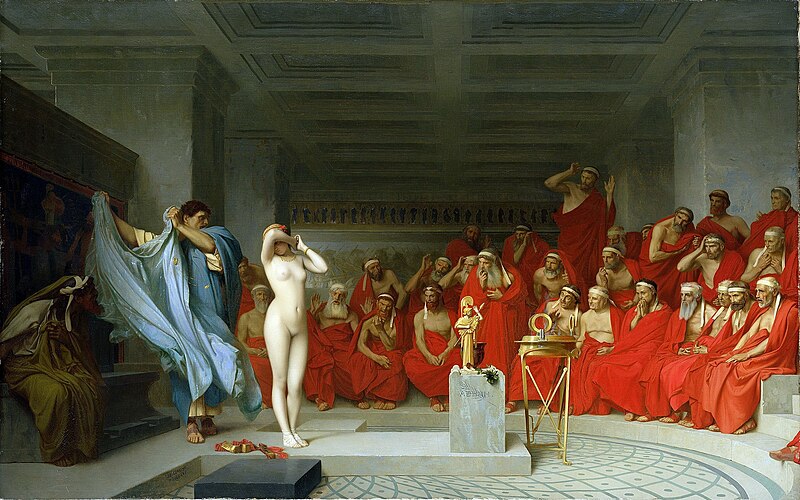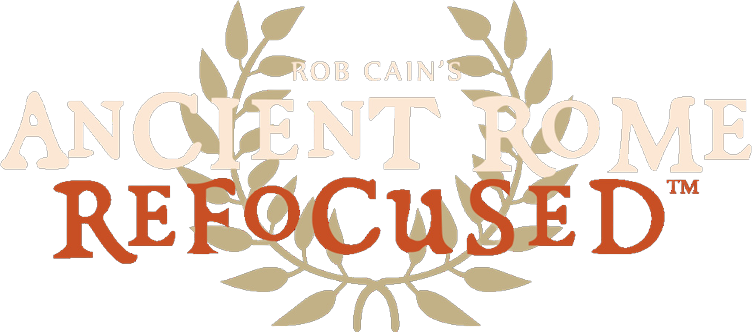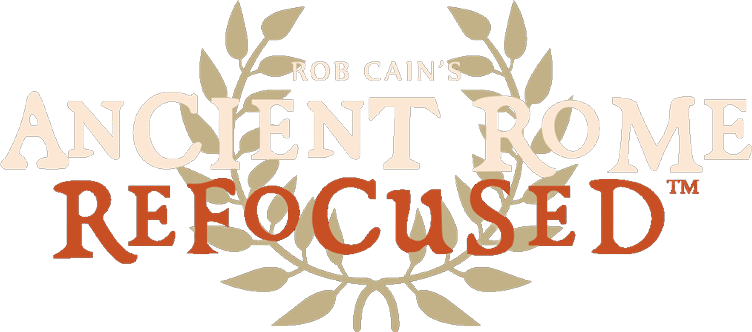The imagery is the cover of the book Trying Neaira. The painting is from the 1861 painting by the French artist Jean-Léon Gérôme. It is voyeuristic. No question. However, whatever ones thoughts on the subject of nudity, in one glaring imagery it gets across the sexual politics of the age, and the subject of the book. I sent some questions to Debra Hamel, the author. She responded by email. The opening below is what I wrote in 2013. There is a bit of an intro and then Ms. Hamel responds to the questions I sent her. I have titled this post ‘Sexual Politics in Tunic World. The important thing to remember is it was a different world.

2013/09/05
Intro: Pay no heed to the calendar. Whether we wear a chiton or an Armani suit, man gets jealous, man lusts, man rages, and man still plays the game of sexual politics. Reading this book I could not help but think of the cases that have been played out all over the world in different countries, in different times, in different languages, in different dress, with the accusations slightly varying in assorted languages and dialects. This book allowed me to look into the Ancient Greek world, but reading this book makes me wonder what is coming into the next court docket of my own time. Trying Neaira? What about Trying Ann? Trying Elizabeth? Enter the world of the ‘True Story of a Courtesan’s Scandalous Life in Ancient Greece.’
Ssh, the case is about to begin.
–Rob Cain
Excerpt from the book, ix, PREFACE.
Apollodorus was just getting started on his denunciation of the defendant, Neaira (pronounced “neh-EYE-ruh”). A bunch of them [dinner guests] had sex with her while she was drunk,” he tells the jurors, describing the aftermath of a dinner party given some thirty years before. “Even the slaves.”
end —
Interview with Debra Hamel, author of ‘Trying Neaira.’
- Who was Neaira?
Neaira was a woman who lived in Athens and was brought to trial there during the mid-fourth century B.C. She was not an Athenian, and we don’t even know if she was of Greek extraction. She was enslaved as a child to a Corinthian brothel-keeper, a woman named Nikarete who ran a string of higher end prostitutes (hetairai). When Neaira was in her twenties she was purchased by two of her regular customers–they enjoyed her on a sort of timeshare basis. And not very long after that she was able to purchase her freedom from them. A few years later she became involved with an Athenian named Stephanos. She moved to Athens with him and lived with him for some thirty years. At that point she was prosecuted by a man named Apollodorus–more on this below–and this is why we know as much about her as we do: Apollodorus’ prosecution speech from the trial (or perhaps an edited version of it) survives. Unfortunately, we don’t have any defense speeches from the trial. Nor do we know what the outcome of the trial was: Neaira’s subsequent fate is a mystery.
- Why did you choose to write about a courtesan? What attracted you about the subject?
It wasn’t so much that I was attracted to writing about a courtesan, though the details of her life as they’re discussed in court by Apollodorus make for titillating reading. The idea came to me one day when I happened to read a blurb on the back of a book. It said something about how historical trials have provided the fodder for some excellent micro-histories. I was familiar already with Neaira’s trial, but hadn’t thought to write about it. Now the pieces came together: not only was the case against Neaira inherently interesting because of the subject matter, but the prosecution speech that survived was lengthy, and there was enough meat in the case, I suspected, to warrant a book-length treatment. The case provides a vehicle for discussing not only the ancient sex trade and the complex goings-on in Neaira’s life, but also Athenian legal practices, which are fascinating in themselves.
- Was there a certain measure of freedom in being a hetaira?
Well, certainly hetairai were free to do things that respectable Athenian women could not. Women in Athens were segregated to an extent, confined to the women’s quarters of the house when male company was present, for example. One sign that a woman was not respectable was that she hobnobbed with unrelated men. When we’re told by the prosecution that Neaira “ate and drank in the company of many men,” we know exactly what sort of a girl she was.
- What was the public reason given for the trial?
The central question in Neaira’s trial was the nature of her relationship with Stephanos. The prosecutor charged that she had been living with Stephanos as his wife (rather than as a mistress). At the time, marriages between Athenian citizens and non-citizens were illegal.
- What was the real reason? Was it brought to court more out of vindictiveness and hatred? Surely whether Neaira was a citizen or not, married or not could not have been the real reason for bringing her to court?
Apollodorus, the prosecutor, and Stephanos had a long history. Athens was a litigious society in general, and feuds very often played themselves out in the legal arena. Stephanos and Apollodorus had faced one another in court on a couple of occasions already by the time Neaira was dragged into the mess. Earlier in the 340s, Stephanos had prosecuted Apollodorus in connection with a decree he’d proposed in the assembly. Apollodorus lost the case and was penalized with a fine. A couple years later Stephanos accused Apollodorus of killing a woman. The details of the case are not clear: it’s possible, in fact, that there was no murder. Stephanos, at any rate, failed to convict Apollodorus on the charge. Perhaps he’d never expected to, and the case was just a means of harassing Apollodorus. We don’t know exactly what Stephanos was up to on these occasions, but his attacks appear to have been politically motivated, and it seems likely that he was attacking Apollodorus at the behest of the man’s political opponents. Apollodorus’ prosecution of Neaira, then, was motivated by revenge. He was–and the prosecution comes right out and tells the jury this–retaliating against Stephanos for the previous attacks. Neaira, who would suffer most if she lost the trial, was not the principal target of his ire. She was simply collateral damage in the ongoing feud.
- How old was she when she was brought to trial?
Neaira was probably born in the early years of the fourth century. She was brought to trial in the late 340s, so she was probably between about 52 and 60 at the time.
- Did she have to sit in court while the proceedings took place?
She would have been in court but as a woman she could not speak in her own defense. Female litigants had to be represented in court by a male. In this case, Stephanos spoke for Neaira.
- How would such a trial be conducted?
Some trials in Athens might take a few hours. A trial like Neaira’s, however, would take an entire day, so maybe nine and a half hours in all. The day was divided into three equal parts–one for the prosecution, one for the defense, and one for the jury selection and casting of ballots. The jurors–there were 501 of them at her trial–were selected randomly by a complicated procedure that I describe in the book. There were court officers, men who would watch the water clocks that measured the length of the litigants’ speeches, others who would count the ballots when they were cast–but there was no presiding judge in the sense that we’re familiar with. No one was ruling out evidence, for example, on the grounds that it was not pertinent to the case. There was no summing up at the end or deliberation by the jury. The jurors heard the case and they voted as they pleased: they didn’t have to defend their decisions and could decide their vote according to whatever criteria they liked.
- At that time it was common to torture slaves for evidence. Was there any time during the trial that she could have been tortured? Was that stopped due to the fact that she purchased herself?
Athenian slaves usually could not give evidence in court unless it was extracted under torture. However, they could be subjected to judicial torture only if both parties in the trial agreed to it. The litigant who wanted the slaves to testify would issue a challenge, either demanding that his opponent submit his slaves for torture or offering his own. The other party then had to agree to the process for it to take place, the two sides coming to an agreement about the conditions of the interrogation, for example, and what the result of the procedure would be. If they didn’t agree, the interrogation wouldn’t take place. Neaira was a freedwoman at this point in her life and so was not subject to torture. During the trial, however, Apollodorus challenged Stephanos to surrender four of her slaves for torture. Stephanos declined the challenge. Perhaps he didn’t want Neaira’s future to depend on the slaves’ testimony, or perhaps his refusal was prompted by feelings of affection: the slave women in question had been in Neaira’s service for at least thirty years by this time.
- Tell us about Phano?
Phano was…well, that’s the question. She was the daughter of either Neaira or Stephanos or perhaps both. The prosecution in the case would like us to believe that she was Neaira’s daughter, and thus not an Athenian citizen. Stephanos had married her off–twice–to Athenian citizens, which would have been illegal if she weren’t a citizen. Apollodorus offers this as proof that Neaira and Stephanos were living as husband and wife. His argument is slippery, and he slings a lot of mud, and it’s impossible, 2500 years hence, to know what the truth was. It may have been equally hard for the jurors hearing Neaira’s case to figure out the truth of the matter.
- How would a guilty verdict in this case have affected Nearia?
A document preserved in the prosecution speech, which may or may not be authentic, says that Neaira would be enslaved if she were found guilty. This is credible, whether the document is authentic or not.
- How did you research this book?
There was nothing exotic about it, no travels to foreign locales for example, just a lot of forays into the stacks at Yale. Apart from a careful reading of the prosecution speech, it was a question of digging into current scholarly opinion on various issues. What’s interesting is that the process of writing Trying Neaira–which was published in 2003–was quite different from what I went through writing my next book, which was published in 2012. In the interim a lot of material had gone on the internet. It was much easier to find a lot of stuff, and to find information I probably wouldn’t have come across absent the internet.
- Tell us something about your other books?
My first book was a scholarly monograph, a somewhat cleaned up version of my doctoral dissertation, entitled Athenian Generals: Military Authority in the Classical Period. In it I discuss the degree to which Athens’ generals exercised authority in the military sphere, and the means by which the Athenian demos–the sovereign people–maintained control over the generals. You can grab a copy on Amazon for a mere $142.00, it looks like. That was published in 1998. Neaira came out in 2003. And last year, 2012, Johns Hopkins University Press published my Reading Herodotus: A Guided Tour through the Wild Boars, Dancing Suitors, and Crazy Tyrants of The History. This is what I call in the introduction to the book a “good parts version” of Herodotus (the reference is to William Goldman’s The Princess Bride), a version of the History for the general reader who’s interested in the History but doesn’t want to slog through the boring bits to find out what it’s all about. It’s not a collection of translated passages: I retell the stories while providing the background information necessary for readers unfamiliar with Greek history. And I bring in a lot of relevant (or, at least, interesting) modern information–references to The Simpsons and Mark Twain and Tennessee Williams, for example. There’s a lot of great stuff in Herodotus: voyeurism and historically significant flatulence, medicinal urination, flying snakes, prophetic dreams, gold-digging ants–to say nothing of the Persian Wars themselves. It was a fun book to research and write.
I also experimented with self-publishing last year, using Amazon’s digital services. I published a booklet called The Mutilation of the Herms: Unpacking an Ancient Mystery. (It’s available for the Kindle and in paperback.) It’s about an event that occurred in Athens in 415 B.C., shortly before the Athenians launched their great (and ill-fated) expedition to Sicily: a bunch of statues throughout Athens were vandalized during the night. These were herms, statues of the Greek god Hermes with his head sitting atop a plinth and an erect phallus poking out the front. The damage was widespread and thus clearly an organized effort, and the business was taken very seriously by the Athenians. It led to an inquiry and the exile or execution of a number of men, and it arguably had a devastating effect on Athens’ prosecution of their war with Sparta. As with my Neaira and Herodotus books, The Mutilation of the Herms is written for a general audience. You don’t have to know anything about ancient history going in.
- What’s next?
I’m currently working on a book on the Battle of Arginusae, a naval battle that took place off the coast of modern Turkey in 406 B.C. It was Athens’ last victory of the Peloponnesian War. It was, in fact, a stunning victory: the Athenians had had to put a new fleet together in the face of an emergency. They managed to do so and manned the fleet with pretty much anyone they could find, going so far as to offer freedom to any slaves who enrolled for service as oarsmen. They sailed out, met the Spartan fleet, and managed to win–despite that at this point the Spartans were technically superior at sea. Losing the battle would almost certainly have meant total defeat for the Athenians, so this was a huge win. But–for reasons I’ll explain in the book–it turned into one of the worst disasters in Athens’ history….
BIO:
Debra Hamel is an American historian specializing in Ancient Greece. Hamel was born in 1964 in New Haven, Connecticut. She graduated from John Hopkins University in 1989 with a Bachelor of Arts degree in classics with departmental and general honors. Hamel studied at Yale University and graduated with an M.A. and M.Phil. in classical languages and literatures in 1993. She received her Ph.D. in 1996, with the dissertation Athenian Strategoi: The Extent and Exercise of Authority in the Military Sphere. From 1998 to 2001 Hamel was Visiting Assistant Professor at Wesleyan University. Debra Hamel’s main topics are Ancient Greek law and Greek military history.
A.P. Style Guide Delenda est




